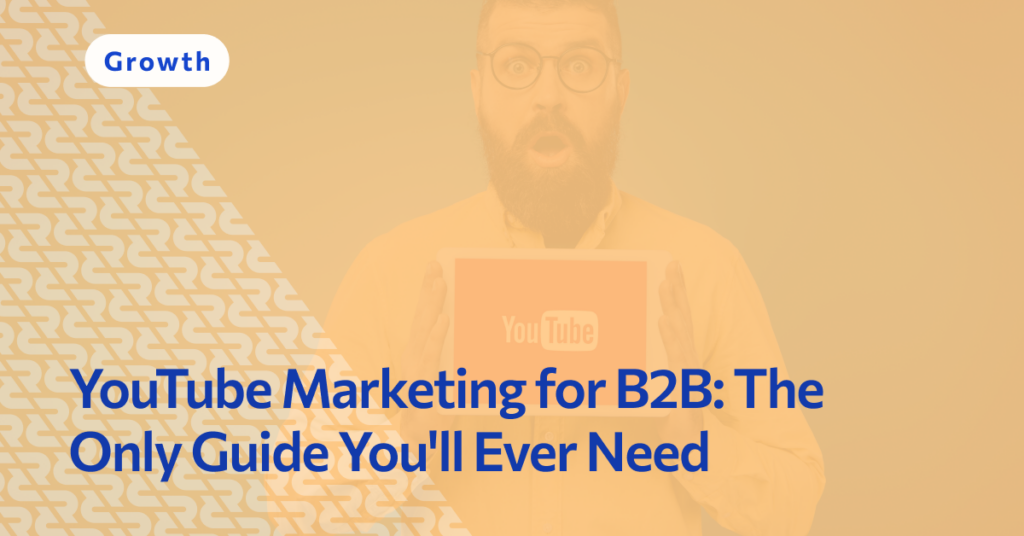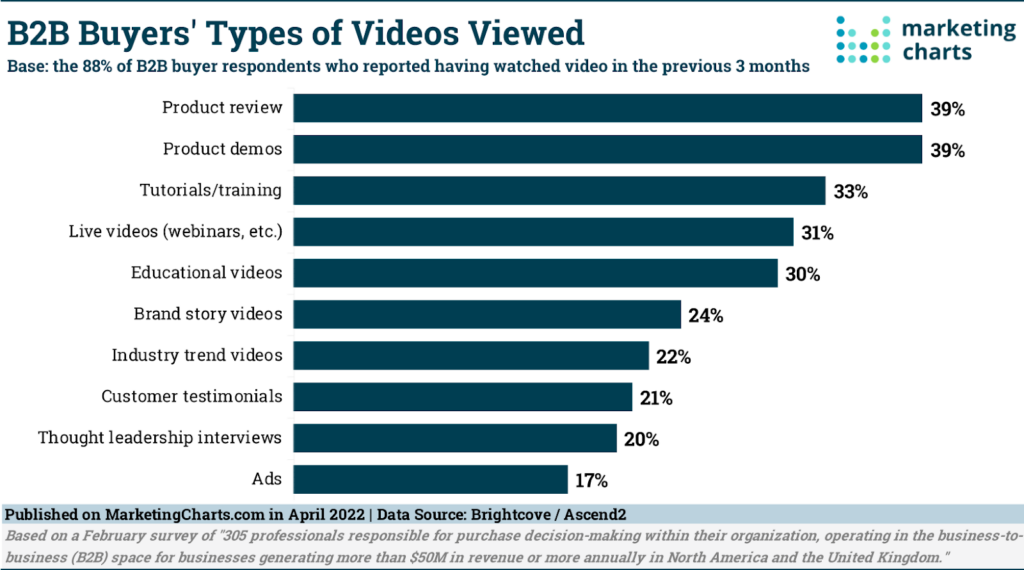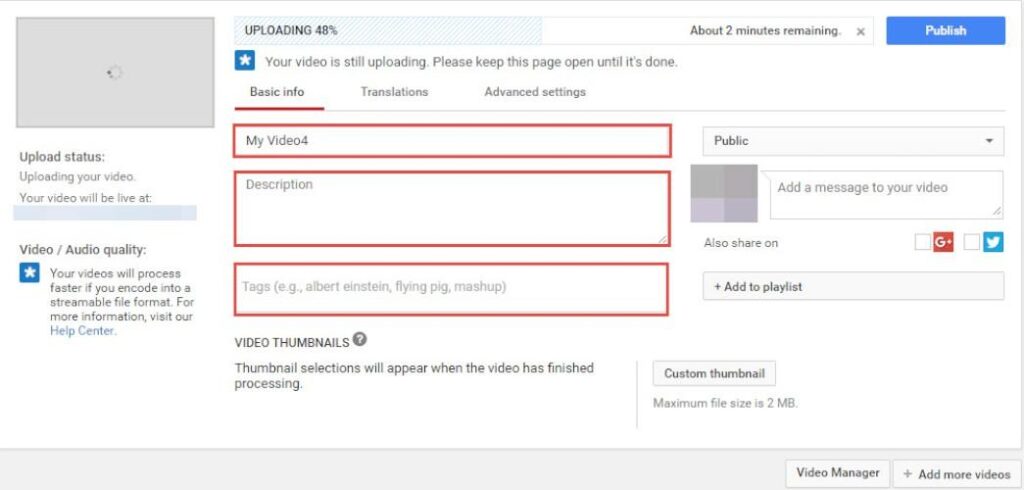YouTube Marketing for B2B: The Only Guide You’ll Ever Need

Video has emerged as the most popular and engaging form of content for every kind of buyer—including those in the B2B world. It keeps audiences engaged and helps drive them down the sales pipeline. It’s no surprise, then, that many companies are adding YouTube B2B marketing to their strategies.
Leveraging YouTube combines the power of video with the visibility of the world’s largest video platform, giving you the opportunity to reach your target audience at unprecedented scale. In this article, we’ll explore the ins and outs of YouTube for B2B marketing and 10 steps to building a strategy that delivers for your unique business.
Quick Takeaways:
- B2B buyers believe video is important for building trust in a brand, and beats other content types for building awareness of business-related problems.
- YouTube is by far the largest video platform, with 2B+ active users.
- Powerful benefits of YouTube include its built-in analytics features, easy integration with other marketing tools, and high shareability.
- Many companies choose to hire video production efforts to uplevel their video quality and save time for their internal teams.
Why Use YouTube for B2B Marketing?
The shift toward video content in recent years isn’t just a trend—it’s a direct response to the evolving preferences of buyers in every market, B2B included. Today, 93% of B2B buyers say that video content is important to them when it comes to building trust in a brand.
At the same time, 70% say it beats other content types when it comes to building awareness of business related problems. In a marketing landscape that’s all about speaking to customer pain points and needs, this advantage can’t be overstated.

YouTube is by far the largest video platform in the world, with a whopping 2.7 billion logged in users every month. In other words: If you’re planning to incorporate video into your larger B2B marketing plan, YouTube is the channel to use. It’s indispensable benefits include:
- Expansive Reach and Diverse Audience: As the #2 website in the world, YouTube is nearly ubiquitously visited by internet users. This includes B2B professionals and decision makers.
- Decision-Making Impact: With video now aiding 95% of B2B buyers in their decisions, using the world’s most popular video platform for B2B marketing is an objectively smart strategy.
- Integration into Digital Marketing Strategies: YouTube can seamlessly integrate with broader digital marketing strategies. It complements other channels like LinkedIn, email campaigns, and your company website, creating a cohesive and multi-faceted online presence.
Leveraging these undeniable benefits of YouTube for B2B marketing allows companies to align their content strategies with buyer engagement preferences, all while confidently reaching target audiences on a familiar platform they already enjoy using.
In the next section, we’ll explore how to develop a YouTube marketing strategy that delivers results for your unique business.
10 Steps to Developing a YouTube B2B Marketing Strategy
Creating a YouTube strategy for B2B marketing involves several critical steps. By following these guidelines, you can ensure that your YouTube presence is not only visible but also effectively engages your target audience and supports your business goals. Here are key steps to consider:
1. Define Your YouTube Goals
Your YouTube B2B marketing strategy should be defined by goals that align with your larger business objectives. Start by clearly defining what you hope to achieve with your YouTube channel. This could be increasing brand awareness, lead generation, establishing thought leadership, or supporting customer education and success.
This will help you determine the types of videos you’ll create, their tone, and the content they need to include. Use a framework like SMART to ensure that your goals are clear, measurable, and designed to be used for tracking performance.
2. Understand Your Audience
Like any other type of marketing content, your YouTube videos should be created with a target audience in mind. That probably means not every video will be geared toward every audience. Rather, you’ll create a diverse library of video content that allows you to engage different audience segments.
To achieve this, research your target B2B audiences and the kinds of content they’re already viewing on your website (i.e. blog topics, product/solution pages, etc.). Then, plan your video content accordingly.
3. Analyze Competitors and Industry Trends
Look at what your competitors are doing on YouTube. Identify gaps in their content that you can fill. This might be related to content topics itself as well as video quality. Stay updated on industry trends to keep your content relevant and timely as your landscape evolves over time.
4. Develop a Content Strategy
Plan the types of videos you will produce. This can include tutorials, product demos, customer testimonials, thought leadership talks, or industry updates—all of these and more are in demand by B2B buyers using video to guide their decisions.

5. Create a Content Calendar
Consistency is key in YouTube marketing. Develop a content calendar to plan and schedule video creation and uploads. This ensures a regular posting schedule that your audience can look forward to. It also gives you a holistic view of your strategy so you can evaluate topic coverage, audience segments, and more.
6. Optimize for SEO
Just as with text content, SEO is important to the visibility of your YouTube videos. SEO for video includes researching and using relevant keywords in video titles, descriptions, tags, and more.

7. Engage with Your Audience
YouTube is ultimately a social media platform, which means direct engagement with your audience is essential. As you publish YouTube videos, interact with your audience to make them feel more connected to you. Respond to viewer comments, encourage discussion, and consider audience feedback to guide your future video content creation.
8. Promote Your Channel
One of the best things about YouTube for B2B marketing is the high shareability of videos published there. Leverage other digital marketing channels like your website, email newsletters, and social media to promote your YouTube content. Cross-channel promotion can significantly increase your reach.
9. Measure and Analyze Performance
YouTube offers built-in analytics you can use to monitor performance of your YouTube videos and continually refine your strategy. Get familiar with YouTube Analytics and use it to monitor important KPIs that deliver actionable insights to your marketing team.
10. Hire Video Professionals to Help
The quality of your video content is pivotal in B2B YouTube marketing. Professional video production can enhance your brand’s perception, showcasing the kind of professionalism and credibility that is essential in the B2B world.
Hiring third-party video production experts ensures technical excellence in your filming, editing, and sound, while also bringing creative insights to craft compelling visual stories. At the same time, it saves your internal teams potential hours spent on video content creation that they can reallocate to more strategic activities.
Enhance Your Content-Driven Outbound Strategy
Content is a critical element of every successful B2B outbound marketing and sales strategy, and RevBoss can help you execute yours with precision. Our outbound lead-gen platform and services are custom-built for SaaS companies, agencies, startups, and other high-growth B2B companies.
Schedule a quick call with us to learn how RevBoss can help you win more clients.
